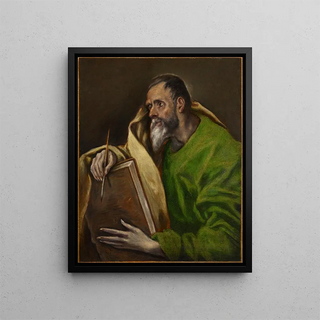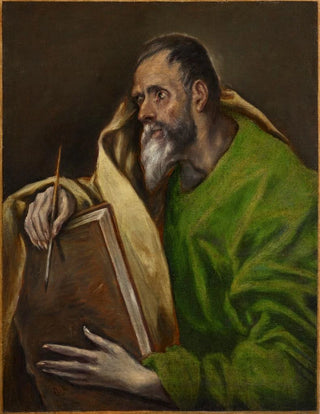Saint Luke Painting - El Greco | Art print


View from behind

Frame (optional)
Saint Luc - El Greco – Captivating Introduction
The artwork "Saint Luc" by El Greco, painted at the end of the 16th century, stands as a true ode to light and spirituality. This painting, depicting the patron saint of artists, is much more than a simple religious illustration. It embodies a unique vision of the world, where faith and art meet in sublime harmony. The saint's posture, holding his brush and his book, evokes both divine creation and artistic inspiration. Through this piece, El Greco invites us to contemplate the beauty of the human spirit, while immersing us in a mystical atmosphere that transcends time.
Style and uniqueness of the artwork
El Greco's style is immediately recognizable thanks to his vibrant colors and elongated forms. In "Saint Luc," the artist employs a rich palette, blending gold tones with shades of deep blue, creating an ambiance that is both warm and contemplative. The drapery of the saint's garments, carefully rendered, demonstrates impressive technical mastery. The way light reflects on the surfaces, accentuating contours and textures, reveals a particular sensitivity to light—a fundamental element in the artist's work. This painting, through its expressiveness and depth, embodies the transition between the Renaissance and the Baroque, making it a key milestone in art history.
The artist and his influence
Born in Crete in 1541, Doménikos Theotokópoulos, known as El Greco, established himself as one of the undisputed masters of Western painting. After studying in Venice and Rome, he settled in Toledo, where he developed a unique style that marries Byzantine influences with elements of Italian Renaissance. His ability to express intense emotions through color and form profoundly influenced many artists, both contemporaries and successors. Painters such as Picasso and Soutine recognized El Greco's impact on their own work, testifying to the importance of his artistic legacy. Through works like "Saint Luc," El Greco captured the essence of the...

Matte finish

View from behind

Frame (optional)
Saint Luc - El Greco – Captivating Introduction
The artwork "Saint Luc" by El Greco, painted at the end of the 16th century, stands as a true ode to light and spirituality. This painting, depicting the patron saint of artists, is much more than a simple religious illustration. It embodies a unique vision of the world, where faith and art meet in sublime harmony. The saint's posture, holding his brush and his book, evokes both divine creation and artistic inspiration. Through this piece, El Greco invites us to contemplate the beauty of the human spirit, while immersing us in a mystical atmosphere that transcends time.
Style and uniqueness of the artwork
El Greco's style is immediately recognizable thanks to his vibrant colors and elongated forms. In "Saint Luc," the artist employs a rich palette, blending gold tones with shades of deep blue, creating an ambiance that is both warm and contemplative. The drapery of the saint's garments, carefully rendered, demonstrates impressive technical mastery. The way light reflects on the surfaces, accentuating contours and textures, reveals a particular sensitivity to light—a fundamental element in the artist's work. This painting, through its expressiveness and depth, embodies the transition between the Renaissance and the Baroque, making it a key milestone in art history.
The artist and his influence
Born in Crete in 1541, Doménikos Theotokópoulos, known as El Greco, established himself as one of the undisputed masters of Western painting. After studying in Venice and Rome, he settled in Toledo, where he developed a unique style that marries Byzantine influences with elements of Italian Renaissance. His ability to express intense emotions through color and form profoundly influenced many artists, both contemporaries and successors. Painters such as Picasso and Soutine recognized El Greco's impact on their own work, testifying to the importance of his artistic legacy. Through works like "Saint Luc," El Greco captured the essence of the...
12,34 €






